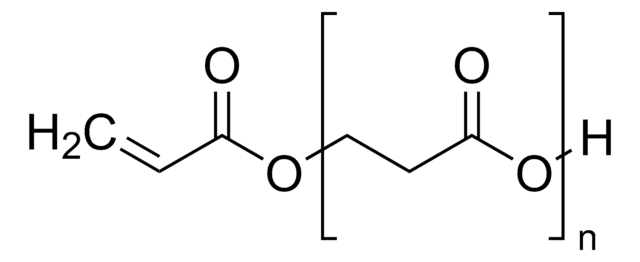552348
2-Carboxyethyl acrylate
contains 900-1100 ppm MEHQ as inhibitor
Sinónimos:
β-(Acryloyloxy)propionic acid, β-Carboxyethyl acrylate, 3-(Acryloyloxy)propionic acid, 3-Acryloyloxypropanoic acid, Acrylic acid 2-carboxyethyl ester, Acrylic acid dimer
About This Item
Productos recomendados
contains
900-1100 ppm MEHQ as inhibitor
refractive index
n20/D 1.457 (lit.)
pH
2.95 (10 wt. % in H2O)
bp
103 °C/19 mmHg (lit.)
solubility
H2O: soluble
density
1.214 g/mL at 25 °C (lit.)
storage temp.
2-8°C
SMILES string
OC(=O)CCOC(=O)C=C
InChI
1S/C6H8O4/c1-2-6(9)10-4-3-5(7)8/h2H,1,3-4H2,(H,7,8)
InChI key
CYUZOYPRAQASLN-UHFFFAOYSA-N
Categorías relacionadas
Application
Features and Benefits
signalword
Danger
hcodes
Hazard Classifications
Eye Dam. 1 - Skin Corr. 1B
Storage Class
8A - Combustible corrosive hazardous materials
wgk_germany
WGK 3
flash_point_f
230.0 °F - closed cup
flash_point_c
110 °C - closed cup
ppe
Faceshields, Gloves, Goggles, type ABEK (EN14387) respirator filter
Certificados de análisis (COA)
Busque Certificados de análisis (COA) introduciendo el número de lote del producto. Los números de lote se encuentran en la etiqueta del producto después de las palabras «Lot» o «Batch»
¿Ya tiene este producto?
Encuentre la documentación para los productos que ha comprado recientemente en la Biblioteca de documentos.
Los clientes también vieron
Nuestro equipo de científicos tiene experiencia en todas las áreas de investigación: Ciencias de la vida, Ciencia de los materiales, Síntesis química, Cromatografía, Analítica y muchas otras.
Póngase en contacto con el Servicio técnico













![Bis[2-(methacryloyloxy)ethyl] phosphate](/deepweb/assets/sigmaaldrich/product/structures/128/336/4e7a3e38-338c-423e-95b8-70d9d1f8e121/640/4e7a3e38-338c-423e-95b8-70d9d1f8e121.png)

